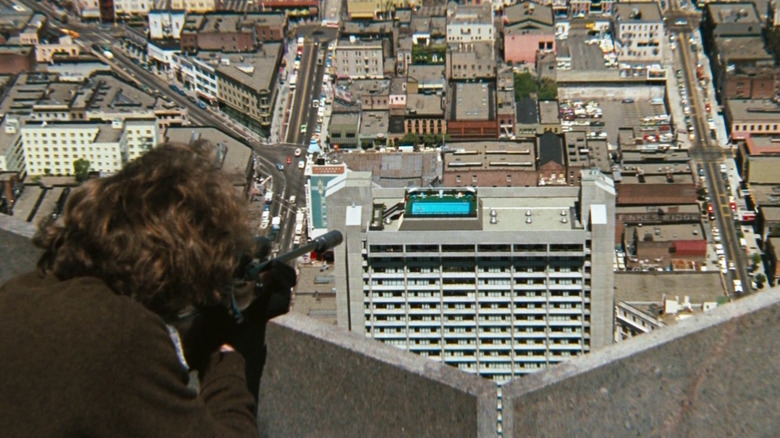Frank Sinatra's Advice Changed One Of Clint Eastwood's Biggest Movies
San Francisco may lag behind the likes of New York and Los Angeles in terms of sheer volume of films shot on location in the city, but it makes up for it with some extremely memorable screen appearances. There was the giant octopus attack in "It Came From Beneath the Sea," with real footage of the Golden Gate Bridge spliced with Ray Harryhausen's creature on the rampage. Steve McQueen was behind the wheel for the famous car chase in "Bullitt," and Ryan O'Neal and Barbra Streisand topped it with the best action scene ever in "What's Up, Doc?" Union Square was the setting for Gene Hackman's wire-tapping in "The Conversation," and Alcatraz Island took center stage in "The Rock". Then there was "Dirty Harry," the best Frisco movie of the 1970s, and weirdly, we have Frank Sinatra to thank for that choice of location.
Ol' Blue Eyes may be best remembered as a crooner and the Rat Pack's Chairman of the Board, but the legendary singer was one of several high-profile actors in contention to play "Dirty" Harry Callahan before Clint Eastwood made it his signature role. Indeed, Sinatra was even attached to the project before a hand injury forced him to walk away from the film. In hindsight, he may seem like a strange choice to play a maverick cop who shoots first and asks questions later, but at the time, he was a very capable actor who fostered a tough guy image.
While Sinatra starred in many lightweight musical comedies that weren't particularly demanding, he also gave strong performances in a number of more serious movies. He won an Oscar for his supporting turn in "From Here to Eternity," picked up a lead actor nomination for "The Man with the Golden Arm," played a troubled veteran (opposite his pal Dean Martin) in the underrated "Some Came Running," and scored a wartime action hit with "Von Ryan's Express." Then, in the late '60s, Sinatra starred in a trio of hard-boiled crime movies: "Tony Rome," "The Detective," and "Lady in Cement," a sequel to the first. Next up was a gritty cop thriller tentatively titled "Callahan," and Sinatra had the clout to influence where the film would be shot.
Dirty Harry is a showcase for San Francisco
During a phone interview with a Bay Area radio station in 1970, he stated the screenplay for "Callahan" was a "darn good script" packed with melodrama and suspense. He also hoped that the producers could get someone like John Frankenheimer to direct, who Sinatra had previously worked with on "The Manchurian Candidate." With shooting set for October of the same year, he also talked about the choice of location:
"It was gonna be shot in New York and I chose San Francisco, we changed it, because I thought San Francisco has never ... I don't think it's ever been photographed as well as it should be, actually."
Alas, by December 1970, Sinatra was out, reportedly walking away from the role due to Harry's choice of weapon. He had suffered a hand injury while filming "The Manchurian Candidate" (a film that featured the most evil movie mother of all time) and had only recently undergone surgery to fix a tendon problem. According to his friend Robert Davi, Sinatra took one look at the gun and said: "I'm afraid it's a little too big for my hands." Many years later, Clint Eastwood said he thought the excuse was "pretty lame," but Sinatra's loss was his gain, and he teamed up again with Don Siegel (after "Coogan's Bluff," "Two Mules for Sister Sara," and "The Beguiled") for one of the biggest movies of his career. So although the star and director changed, Sinatra's location pick remained. It arguably made the movie.
With cinematographer Bruce Surtees onboard, "Dirty Harry" became a shimmering showcase for the City by the Bay. Basking under blue skies in bright sunshine, the movie starts with a spectacular panorama from the top of 555 California Street. It's here that serial killer Scorpio (Andy Robinson) makes his first kill and Harry finds the ransom note. Accompanied by Lalo Schiffrin's sizzling score, we get plenty of street-level flavor with jangling trams, belching traffic, seedy strip joints, and even a cinema showing Eastwood's directorial debut, "Play Misty For Me." Other landmarks on the whistle-stop tour include San Francisco City Hall; Washington Square (where Scorpio is thwarted while sizing up another victim); the 100-foot-tall cross at the summit of Mount Davidson (the location of ransom drop-off); and the old San Francisco 49ers stadium, where Harry tortures Scorpio. New York would have no doubt worked out just fine as a backdrop, but San Francisco proved to be integral to the atmosphere of "Dirty Harry." Thanks for the advice, Mr. Sinatra!

